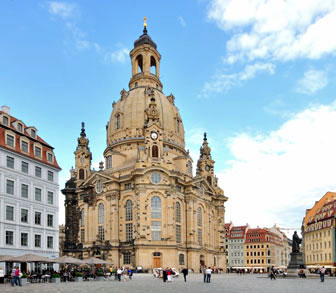Call it an experiment. Suppose I spent 10 days at the Dresden Music Festival, in Germany, going to concerts, talking to staff and musicians, maybe forming some conclusions about what’s going on. What would I and they learn from that?
It all happened because I struck up a warm acquaintanceship with Jan Vogler, the festival’s Intendant, and of course one of the world’s top cellists. Jan had taken the festival in some new directions, onto future-oriented paths he didn’t think other European music festivals went down. What would I think of that?
But there were other reasons, as I learned, why the festival might want an outside eye. It’s not as well known as other European festivals. Start with that. And then Dresden — facing a right-wing, anti-immigrant revival — has a campaign for inclusion, called “Dresden für Alle,” which hardly needs translation. The festival is at least unofficially part of that.
Finally, Dresden — so much of it reduced to rubble in World War II, and then cut off from much of the world because it was in East Germany — doesn’t quite yet think of itself as s major European center. A statement by the president of the Friends of the Dresden Music Festival, which I found in a program-book insert, says the festival can establish Dresden as an important European arts city. Suggesting that it hasn’t been one up to now.
So there’s a lot at stake. The presence of the East, not yet fully vanished into history, sometimes comes to life for a visitor, in casual conversation with Dresdeners. Someone whose English seems perfectly OK apologizes for it, saying he grew up during the East German years (when Russian was the language everybody had to learn). Someone else, hearing talk of a small museum dedicated to the East German past, drily says he wouldn’t want to go there. He spent the first 16 years of his life, he says, in what then was East Germany, and doesn’t need any more of it.
 Plus this. Some of Dresden’s most celebrated historical buildings — like the Frauenkirche (shown in the photo) — are in fact reconstructions, because the originals had been pulverized by bombs. Leading more than one German I met to dismiss them as (in English) “Disneyland.” Not that I’m putting Dresden down! I found it a friendly, thriving, fun-to-be-in city, with terrific food and lots of lively high and popular culture. And I liked the reconstructed buildings, which, if they’re Disneyland, are really well done. But I can see where some people there, especially older ones, might not feel it measures up.
Plus this. Some of Dresden’s most celebrated historical buildings — like the Frauenkirche (shown in the photo) — are in fact reconstructions, because the originals had been pulverized by bombs. Leading more than one German I met to dismiss them as (in English) “Disneyland.” Not that I’m putting Dresden down! I found it a friendly, thriving, fun-to-be-in city, with terrific food and lots of lively high and popular culture. And I liked the reconstructed buildings, which, if they’re Disneyland, are really well done. But I can see where some people there, especially older ones, might not feel it measures up.
So what did I find?
That’s coming in my next posts. But here’s a preview. I heard some of the best orchestral playing I’ve ever encountered, in all my long life in music, from the festival’s own orchestra. You’ll think I’m exaggerating, but I’m absolutely not. To judge from what I heard, this is one of the finest orchestras playing anywhere in the world today, even if most of the world doesn’t know about it. And it’s unique, for reasons I’ll explain in a further post.
Plus a terrific concert by the Dresden Streichphilharmonie, a youth string orchestra. And a killer show by violinist Pekka Kuusisto (whom I’ve already raved about in this blog).
And then the future-oriented innovations, which were real. Though I could question — as I’ve also done with innovations in the U.S. — whether they add up to a coherent strategy.
I did some informal consulting, about the festival’s plans for attracting the elusive new, young audience that everyone in classical music wants. The details of that are the festival’s business, not the blog’s.
But this much I can say: The problems classical music has in Dresden seem much the same as what we see in the U.S.
Original Content: 10 days in Dresden
No comments:
Post a Comment